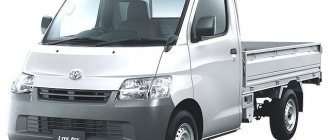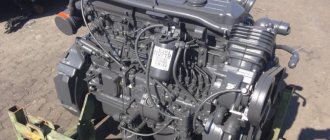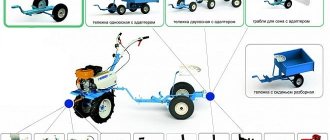The “Vito in the 638th body” was equipped with five diesel “fours”: The atmospheric part consisted of units with a volume of 2.1-2.3 liters, developing from 79 to 98 horsepower and from 152 to 230 Nm of torque, and the turbodiesel part - from a 2.1-liter engine , which, depending on the degree of boost, produces 102-122 “horses” and 250-300 Nm.
There were also gasoline engines: four-cylinder units of 2.0-2.3 liters with a capacity of 129-143 horsepower, generating 186-215 Nm, as well as a 2.8-liter V-shaped “six” with a potential of 174 horsepower and 237 Nm of thrust. A 5-speed manual or 4-speed automatic transmission is responsible for supplying torque to the front wheels.
The first generation of Mercedes Vito is built on a front-wheel drive architecture, the engine is placed longitudinally. The front suspension of the car is of an independent design with MacPherson struts, and the rear suspension is of trailing arms.
The rack-and-pinion steering is equipped with a hydraulic booster, and all wheels are equipped with disc brakes, supplemented with ventilation at the front. The main advantages of the “first Vito” are high-torque and economical engines, good-looking appearance, excellent driving performance, good capabilities for transporting cargo, comfortable suspension, decent basic equipment and overall reliability of the design. The disadvantages are low corrosion resistance, high prices for original spare parts and excessive vibrations from diesel units.
Model history
Mercedes Vito W638 debuted in 1996. The assembly of minibuses was established in Spain. Vito is based on the Volkswagen T4 Transporter platform. The body was designed by German designer Michael Mauer. Why did the van get the Vito badge? The name comes from the Spanish city of Victoria, where it was produced.
Two years after the start of sales, the minibus was updated. In addition to the new diesel engines with common rail injection (CDI), there are also subtle stylistic changes. For example, orange turn indicators have given way to transparent ones. The first generation Vito was produced until 2003, until its successor entered the market.
Salon
The car was equipped with the most comfortable interior, which differed significantly from the interiors of commercial vehicles from other manufacturers. There was a pleasant “Mercedes” design, high-quality finishing materials, highly professional assembly of parts and much more.
The driver's seat has optimal filling and pronounced support. The same can be said about the front passenger seat. There is a wide range of adjustments in different ranges. Both the driver and front passenger have individual armrests. It is quite comfortable in other rows of the first generation Vito. There are also air ducts and a large supply of free space.
In front of the driver is a powerful 4-spoke steering wheel, followed by a dashboard that was classic for Mercedes at that time with yellow arrows and a speedometer in the very center.
At the top of the center console there are air ducts, and below it is the climate control unit. Even lower is the audio system and control buttons for various parts of the car, and this common slightly protruding block ends with the gearshift knob. Below there is another large block, represented by several niches. The central tunnel is completely absent, and the handbrake is located on the left under the steering wheel.
Engines
Gasoline:
R4 2.0 (129 hp) - 200, 113;
R4 2.3 (143 hp) - 230, 114;
VR6 2.8 (174 hp) - 280.
Diesel:
R4 2.2 (82, 102-122 hp) - 108 CDI, 200 CDI, 110 CDI, 220 CDI, 112 CDI;
R4 2.3 (79-98 hp) - 180 D, 230 TD, 110 D.
It's true that gasoline engines cause far fewer problems than diesel engines, but they consume a lot of fuel. Those who use the Vito as a commercial vehicle prefer diesel engines. Unfortunately, diesel engines have great difficulty in accelerating a car, even the most powerful ones.
There were two diesel units to choose from. All of them have an almost eternal timing chain drive. Which unit has proven itself best during operation? The 2.3-liter turbodiesel was the outsider. It has problems with the injection system - the injection pump fails. There are also cases of premature breakage of the generator drive belt and pump, and even burnout of the head gasket.
The 2.2-liter unit, despite its more complex design, is much more reliable and economical. Although here there are also problems in the injection system. Glow plugs fail quite quickly, usually due to a burnt-out relay.
Motors
Common problems
The layout features of the engines under the hood forced the manufacturer to use a radiator with a built-in expansion tank and arrange the units very tightly. Extensive maintenance usually involves removing the front panel and radiators. And to gain access to the souring turbine rods and to the turbine itself, quite often they simply saw through a window in the body, at the passenger’s feet. This allows you to change Chinese turbines in literally fifteen minutes, which is important for those who operate the car in the “just as long as it drives” style. Generally not the worst life hack, but it says a lot about the attitude towards repairs, because servicing on a lift is a little more difficult and takes longer.
Technical features
Regardless of the version, the Mercedes Vito W638 is always front-wheel drive. Richer versions were sometimes equipped with air springs on the rear axle.
Safety? The car did not participate in EuroNCAP crash tests. But given the fact that most copies are already heavily corroded, a used Mercedes Vito 638 is unlikely to be able to guarantee high-level safety.
A lot of good words can be said about the chassis. The minibus behaves almost like a car.
Typical faults
During production, the car was twice called for service campaigns. The first was in 1998 due to problems with Continental and Semperit tires. The second - in 2000 to eliminate problems with the brake booster.
Vito's weakest point is corrosion. It's all about poor body protection. Rust appears literally everywhere. The first outbreaks, as a rule, appear on the lower corners of the doors, hood, and rear trunk door. Before you settle on a specific instance, you should take a closer look at the thresholds, floor and, if possible, look under the door seal.
If there are no traces of rust on the body, then it has probably been repaired. In most cases, this work is done hastily just to make the car look nice at the time of sale. Be on the lookout!
There are also electrical problems. In diesel versions, the glow plug relay is acting up. The starter, alternator, radiator fan, power windows and central locking often fail. The thermostat is another part that will soon need to be replaced. From time to time the air conditioning system and heater “show character”.
Before purchasing, be sure to check the operation of the side sliding doors, which jam if the guides are damaged. Owners complain about the very low quality of the interior plastic - it makes unpleasant sounds while driving.
Sometimes gearbox cables and universal joints fail. The 4-speed automatic transmission does not cause problems, provided that the operating recommendations for changing the oil are followed. The Vito's steering mechanism is not very durable - play appears quite quickly.
Transmission
Common problems
Since the cars are strictly front-wheel drive, and were produced by Mercedes in the nineties, everything is excellent from a mechanical point of view. Drives do not rust, splines do not chip, CV joints last a long time as long as there are boots and lubricant. And all this despite the fact that this is the company’s first experience in producing transmissions for a configuration with a transverse power unit.
Mechanical boxes
The five-speed manual transmission in the Vito is very reliable, as it should be. But the shift system with cables and a complex selection mechanism turned out to be a weak point. First of all, the mechanism slide itself wears out, the plastic U-shaped washer-slider wears out along the working surface, and its plastic shell cracks under excessive loads. All ball joints wear out, both the cable balls and the slider ball. And with real runs over 500 thousand, even the swing axes of the lever wear out. There is another slider in the design of the box, this is a “cube” in the switching mechanism already on the box itself, it is plastic and wears out in just a couple of years. Many people sharpen fluoroplastic or bronze ones as replacements, but in dusty road conditions this does not help for long.
The wear of the axles of the rocker mechanisms and the balancer bushings requires regular attention from the owner. Poor engagement of reverse and second gears, failure to engage fifth – these are all drive problems. But they can also lead to breakdowns of the mechanical part of the box. First of all, fifth gear suffers, the mileage on it is maximum, and under-engagement leads to overload of the clutch, wear of the fork and the fifth gear itself.
Automatic boxes
After 1997, the ZF 4HP20 automatic transmission appeared on the car. There are only 4 stages, but there is electronic control of blocking and pressure, a torque limit of about 330 Nm and a very successful design. By and large, the box has no serious weak points.
With regular oil changes (at least once every 60 thousand), by 250-300 thousand kilometers the torque converter (with replacement of bushings and locking linings) and linear solenoids will require repairs.
If you don’t do scheduled repairs and don’t change the oil, and if you drive actively, then you can break this automatic transmission.
Overheating and dirty oil lead to premature failure of pistons and solenoids. It is also the culprit for early failure of the rolling bearings of the caliper and drive gear, as well as the caliper itself. The oil pump bushing and its cover also wear out. They do not change regularly, so either a machine park and skillful hands, or an assembled replacement will help. The price is quite high, the set costs about 350 euros, which is more than the assembled box in its still living condition.
The moment from powerful diesel engines, if they are in the standard version, the box digests calmly. But if you get carried away with chip tuning (and there are amateurs) and raise the torque, say, to 350 Nm, then when slipping there is a risk of breaking the input shaft at the junction with the drum.
Technical data Mercedes-Benz Vito W638 (1996-2003)
| Version | 108 D | 110 TD | 108 CDI | 110 CDI | 112 CDI |
| Engine | diesel | turbodiesel | turbodiesel | turbodiesel | turbodiesel |
| Working volume | 2299 cm3 | 2299 cm3 | 2151 cm3 | 2151 cm3 | 2151 cm3 |
| Number of cylinders/valves | R4/8 | R4/8 | R4/16 | R4/16 | R4/16 |
| Maximum power | 79 hp | 98 hp | 82 hp | 102 hp | 122 hp |
| Maximum torque | 152 Nm | 230 Nm | 200 Nm | 250 Nm | 300 Nm |
| Dynamics | |||||
| Maximum speed | 148 km/h | 156 km/h | 150 km/h | 155 km/h | 164 km/h |
| Acceleration 0-100 km/h | 20.6 sec | 17.5 sec | n.d. | 18.2 sec | 14.9 sec |
| Average fuel consumption, l/100 km | 8,8 | 9,2 | 7,0 | 8,0 | 8,0 |
Acceleration time
The graph shows the acceleration time of the Mercedes-Benz Vito I (W638) to 100 km/h.
Data is shown for all available modifications. Acceleration time to 100 km/h0 s7.5 s15 s22.5 s2.8 AT, 1996-2003114 2.3 AT, 1996-…114 2.3 MT, 1996…112 CDI 2.2d MT,…112 CDI 2.2d AT,…110 CDI 2.2d AT,...110 CDI 2.3d MT,...110 CDI 2.2d MT,...110 CDI 2.3d AT,...108 CDI 2.2d MT,...12.714.215.117.518.218.220.620.62122
| 2.8 AT, 1996-2003 | 12,7 |
| 114 2.3 AT, 1996-2003 | 14,2 |
| 114 2.3 MT, 1996-2003 | 15,1 |
| 112 CDI 2.2d MT, 1996-2003 | 17,5 |
| 112 CDI 2.2d AT, 1996-2003 | 18,2 |
| 110 CDI 2.2d AT, 1999-2003 | 18,2 |
| 110 CDI 2.3d MT, 1996-1999 | 20,6 |
| 110 CDI 2.2d MT, 1999-2003 | 20,6 |
| 110 CDI 2.3d AT, 1996-1999 | 21 |
| 108 CDI 2.2d MT, 1999-2003 | 22 |
Corrosion in details
Wheel arches.
Thresholds.
Doors.
Rear trunk door.
Rear sliding door.
Faulty parts
If the Vito is often used to transport heavy loads, the air springs may require replacement after 50,000 km.
Drive shaft bearings are not considered durable.
Transmission oil leaks are a chronic problem.
The brake discs last a relatively short time - too small for a heavy van.











